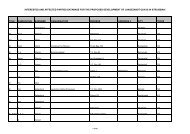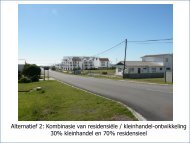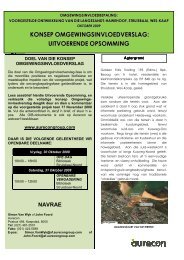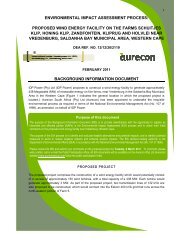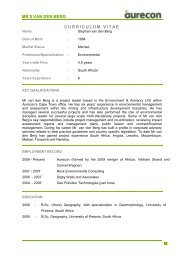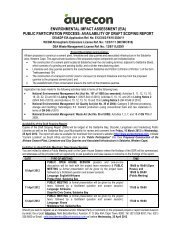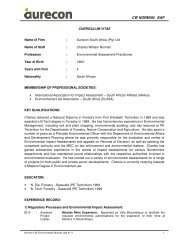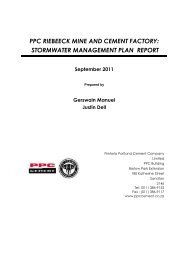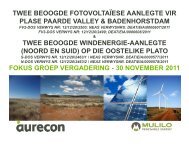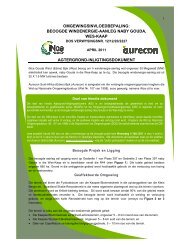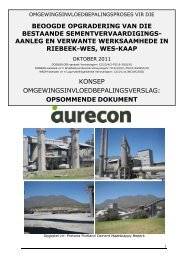Final EIAR - Aurecon AME Environmental | Environmental Projects
Final EIAR - Aurecon AME Environmental | Environmental Projects
Final EIAR - Aurecon AME Environmental | Environmental Projects
You also want an ePaper? Increase the reach of your titles
YUMPU automatically turns print PDFs into web optimized ePapers that Google loves.
Proposed Wind and Solar (Photovoltaic) Energy Facilities on Kangnas Farm near Springbok in the Northern Cape: <strong>Final</strong> EIR 34<br />
Figure 3.2: Typical components of a horizontal axis wind turbine 16<br />
3.2.2.2 Nacelle<br />
Larger wind turbines are typically actively controlled to face the wind direction measured by<br />
a wind vane situated on the back of the nacelle. By reducing the misalignment between wind<br />
and turbine pointing direction (yaw angle), the power output is maximised and non-symmetrical<br />
loads minimised. The nacelle can turn the blades to face into the wind (‘yaw control').<br />
All turbines are equipped with protective features to avoid damage at high wind speeds. By<br />
turning the blades into the wind (‘furling’) the turbine ceases its rotation, accompanied by both<br />
electromagnetic and mechanical brakes. This would typically occur at very high wind speeds,<br />
typically over 72 km/h (20 m/s). The wind speed at which shut down occurs is called the cut-out<br />
speed. The cut-out speed is a safety feature which protects the wind turbine from damage.<br />
Normal wind turbine operation usually resumes when the wind drops back to a safe level. The<br />
turbine controls the angle of the blades (‘pitch control') to make optimal use of the available<br />
wind and avoid damage at high wind speeds.<br />
The nacelle also contains the generator, control equipment, gearbox and wind speed measure<br />
(anemometer) in order to monitor the wind speed and direction.<br />
3.2.2.3 Generator<br />
The generator converts the turning motion of the blades into electricity. A gear box is commonly<br />
used for stepping up the speed of the generator. Inside the generator, wire coils rotate in a<br />
magnetic field to produce electricity. Each turbine has a transformer that steps up the voltage to<br />
match the transmission line frequency and voltage for electricity evacuation/distribution.<br />
3.2.2.4 Tower<br />
The tower is constructed from tubular steel or reinforced concrete and supports the rotor and<br />
nacelle. For the proposed project the tower would be between 60 m and 120 m tall, depending<br />
on the selected turbine. Wind has greater velocity at higher altitudes, therefore increasing the<br />
height of a turbine increases the expected wind speeds.<br />
3.2.2.5 Foundation<br />
Foundations are designed to factor in both weight (vertical load) and lateral wind pressure<br />
(horizontal load). Considerable attention is given when designing the footings to ensure that the<br />
turbines are adequately grounded to operate safely and efficiently. The final foundation design<br />
of the proposed turbines is dependent on a geotechnical investigation; however it is likely that<br />
the proposed turbine foundations would be made of reinforced concrete. The foundations would<br />
be approximately 20 m x 20 m and an average of 3 m deep. The foundation would be cast in<br />
situ and could be covered with top soil to allow vegetation growth around the 6 m diameter steel<br />
tower.<br />
16 Source http://www1.eere.energy.gov/windandhydro/images/illust_large_turbine.gif (accessed<br />
15/11/2010)<br />
© <strong>Aurecon</strong> (2012) No unauthorised reproduction, copy<br />
or adaptation, in whole or in part, may be made.<br />
P:\<strong>Projects</strong>\108495 Kangnas WEF & PV EIA's\3 Project Delivery\4 Reports\FEIR\FEIR 210213 <strong>Final</strong>.doc


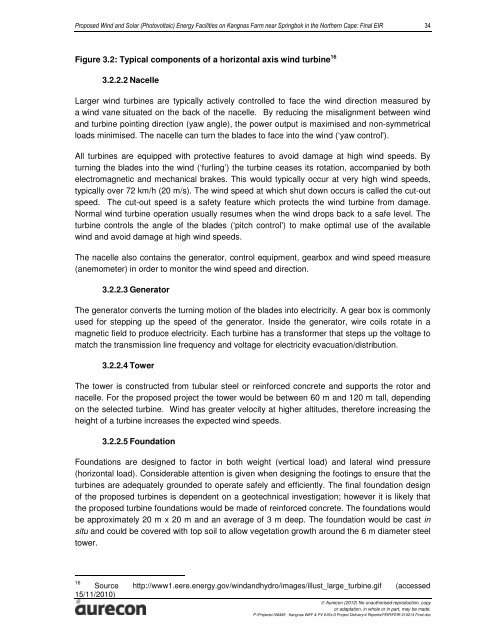
![CRR IV FEIR ~ 26042010 [FINAL].pdf - Environmental Projects](https://img.yumpu.com/21973020/1/184x260/crr-iv-feir-26042010-finalpdf-environmental-projects.jpg?quality=85)
